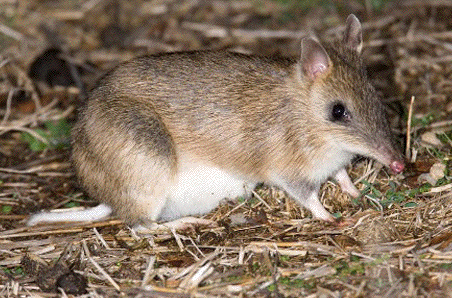 -
- Subclass Marsupialia, order
Peramelemorphia, family Peramelidae, subfamily
Peramelinae. Members of the family Peramelidae
are polyprotodont marsupials, with syndactylous
toes on hind feet. Perameles is characterized
externally as having elongate, pointed ears,
relatively elongate hind feet; being generally
lightly built; and often having transverse bars
present in posterior pelage. Skull is long and
narrow; length is more than twice maximum width.
Five upper incisors are present, P5 about
equidistant between adjacent incisor and canine.
Upper molars have a large hypocone, and
posterior molar is ca. 50% the size of other
molars in occlusal view. Auditory bullae are
small and nearly hemispherical. Dentary does not
have a posterobuccal process.
-
- BEHAVIOR. Perameles gunnii is
essentially solitary, other than when courtship
and mating occurs or when females have dependent
young. Mutual avoidance is usual. Males are more
aggressive than females and occasionally chase
and attack other males, although scarring or
injury is rare (Clunie 1987; Dufty 1994a;
Heinsohn 1966). In a confined reintroduced
population with strong male bias, injury from
fighting was more common. Most behavior in
captivity mimicked that described for wild
eastern barred bandicoots. Adults were tolerant
of juveniles, even those of the same sex (Murphy
1993). Males initiate courtship when a female
becomes receptive; copulation is brief but
frequent, and many males may mate with a single
female over several hours. A maximum of 10 males
mated with a single female, 3&endash;4 times
each; this behavior may have been the result of
a male-dominated population (Dufty 1994a).
Mating is achieved with the male standing erect
behind the crouched female, with his forelegs
folded back against his body. Contact is only in
the genital region. Eastern barred bandicoots of
both sexes usually resume normal foraging
activity postcoitus (Dufty 1994a; Heinsohn
1966).
-
- Eastern barred bandicoots have a limited
range of vocalizations, visual displays, and
social behaviors (Coulson 1990). ''Honking'' is
associated with alarm, and ''sniffing'' is
associated with recognition. The pale belly may
be a visual signal of submission, although
an erect stance with open, gaping mouth
occurs during aggressive encounters
(Clunie 1987).
-
- Perameles gunnii is relatively long limbed
and can move very rapidly quadrupedally using
either a synchronous running or an asynchronous
galloping gait. Sudden jumps (up to 1.5 m high)
during escape responses and the capacity to
rapidly change direction facilitate evasion of
predators (Moloney 1982).
-
- Olfaction plays a significant role in the
feeding ecology of P. gunnii (Quin 1992). Food
is normally obtained by digging conical holes in
soil with front feet. After potential prey has
been located by olfaction, smell may confirm
presence of food during digging (Quin 1985).
Feeding at 1 site may last .25 min, and .90% of
the time may be spent actively foraging or
consuming food items (Heinsohn 1966). Food may
be rolled and kneaded in the forepaws; this
behavior may be due to unfamiliarity with the
item, a need to crush the exoskeleton of
arthropods, or a way to remove irritative hairs
from caterpillars. Drinking is rarely observed;
water is lapped with a forward and upward
movement of the tongue (Dufty 1994a). Eastern
barred bandicoots groom with syndactylous claws
on hind feet. Face and head are groomed with
saliva-moistened forefeet. The body,
particularly the genital area, is cleaned with
the mouth. Other comfort acts include
stretching and yawning, usually upon emergence
from the nest, body shaking when wet, and pouch
cleaning by females (Clunie 1987).
-
- Nests are constructed at or just below
ground level, depending upon season and soil
moisture. Nests are excavated, using only
forefeet, in a rapid scratching motion. Soil and
litter are pushed back through hind legs, and
back is arched to accommodate accumulated
material. Nests may be used for several days but
may also be temporary. On occasion, nests are
built in hollow logs or underneath rocks or
other solid features. In suburban Hamilton,
nests often are made under buildings or in piles
of rubbish. Rabbit burrows are used for shelter
and perhaps also for nesting (Dufty 1994c). Most
(78%) of 20 nests located by radiotelemetry were
within 3 m of a woody plant and were frequently
very cryptic in placement. Nests may be at the
base of a grass tussock and virtually A key to
the species of Perameles follows. impossible to
detect without disturbing the animal (Murphy and
Serena 1993).
-
- Perameles gunnii is principally nocturnal,
often emerging from the nest only during
complete darkness, although animals may be
active during twilight (Heinsohn 1966). Captive
animals did not emerge until almost 3 h after
sunset (Moloney 1982). Activity pattern is
governed by an endogenous circadian oscillator
entrained to photoperiod (Lyne 1981).
-

|



